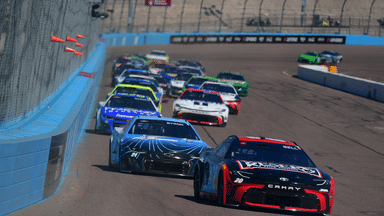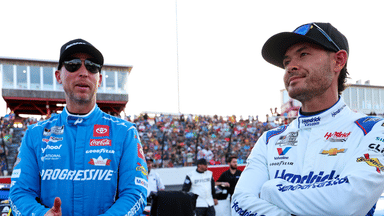Since last Sunday’s race in Dover, aero-blocking has been all the heat in NASCAR. Denny Hamlin used the strategy for most of the final stage to fend off Kyle Larson and ended up crossing the checkered flag 0.256 seconds ahead of him. While Larson and a few others have been calling foul on this tactic, Xfinity Series driver Parker Kligerman has explained what it exactly is and if it is legal as per the books.
Advertisement
Talking with reporter Dustin Long for NBC, he detailed how aero-blocking is when a leading driver gets directly in front of a car that’s following him with the intention of disrupting the air between them. What this does in addition to sending a massive spray of dirty air to the follower is give the leader a better lane to drive faster in.
Using the final battle between Larson and Hamlin as his example, Kligerman analyzed, “He’s making headway [Larson]. So, what does the car in front do? They get told one, by their spotter. Two, they can look in the mirror or the camera within the Next Gen car, and say, ‘Hey, that looks like a pretty fast lane. I’m going to move up to use that lane and do two things.’”
“One, potentially go faster because there’s more grip up there,” he continued. “Or, they’re finding speed utilizing that line just like the other driver behind them. You are also basically making the air worse for the car behind you.” The Xfinity driver noted that Ross Chastain was the best at this strategy and had been the one to teach him how to do it. He concluded with the verdict that there was nothing illegal about the tactic.
What Kyle Larson wants to do about the aero-blocking strategy that cost him a win in Dover
Understandably frustrated at the failure of his multiple attempts to get past Hamlin in the Monster Mile, Larson called for the rear view cameras in the Next Gen car to be removed to help stop aero-blocking. He told the press that having in-car cameras allowed leaders to get a perfect view of who is following them and get in front of them to block the air far too easily.
When Hamlin was confronted with this opinion in his post-race interview, the Joe Gibbs Racing star contradicted by mentioning that he doesn’t rely on his camera as much as he does on his spotter. Moreover, he thought that aero-blocking would still prevail with just the spotter alone and that there wasn’t much sense in removing the rear-view cameras. The ball is in NASCAR’s court, once again, to be dealt with.








